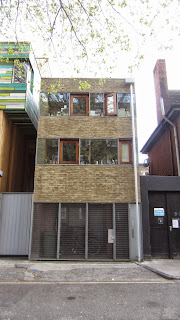Does it still make sense to write enthusiastically about a bold and characterful building I have spotted somewhere in London only to see it under demolition the next week? (Keybridge House, Samson House, the Sterlingesque HMSO on 9 Elms Lane to name but a few of the largest...). Maybe I should have realised how things would go when the first ever building chosen for a B&B visit (Mondial House) turned out to have been demolished months earlier
But so what if a building gets pulled down? As an architect shouldn't I subscribe to the school of thought that nothing lasts for ever? Cedric Price's built-in obsolescence? Can I realistically expect a defunct telephone exchange, petrol station, data bunker etc be conserved like a medieval cathedral...?
Part of the pain comes undoubtedly from watching something you admire replaced by something inferior both architecturally and 'programmatically'....ie remove a crisp industrial shed employing hundreds of people in central city location and replace with bland 'luxury' apartments sold to overseas investors and enjoying an anticipated max occupancy of 40% to 2040.
Another part is the double standard whereby the least distinguished piece of Victoriana is propped up and preserved (often as a frontage only for something utterly alien behind*) while better work from the 20th century is removed without a thought **
..behind you! Not a Police Station anymore. Just a front for a more sinister operation.
Programmatically, which would you prefer to have in central Battersea - the flats or the police??

** BEFORE: (you can read what I liked about this in the original post here)
**AFTER: you can read what i don't like about it here, now: the trad style dormers, the double garage doors, the trad sash windows, the fact that everything that was black is now either white, duck-egg blue, wooden or lead, the herringbone brick...
As a property developer in the UK right now, one thing you can be sure of - and this despite the supposed fashionability of Brutalism - is that you WILL get planning permission to demolish if your target was built or designed between 1960 and 1976. Don't worry about listings. Anything short of the National Theatre itself, and you'll be fine. You will also be congratulated for your efforts by (a) the general public (b) the local authority (c) the media (d) most architects. So it's a no brainer right?
It's difficult to imagine from my perspective, at a point where we will shortly be asked whether we want an old school Labour government to take us back to pre-Thatcherite Britain, that there could be the slightest possibility that the answer will be yes. On the contrary, all the evidence in architecture and urbanism indictates a general acceptance that these two decades be wiped from our collective consciousness, and the quicker the better.
There are of course a few exceptions, one notable, ie Social Housing.
Despite Dame Shirley Porter's ruinous precedent, there still exists in London a significant quantity of welfare state-era social housing (and council tenants to go with it) ensuring some good design and progressive politics remain part of the city's future.
Whilst politics around the 'housing crisis' may have failed to make any significant progress toward addressing it (and right to buy still exists) the feeling is that, sooner or later, something will have to be done, whether it's expansion into the green belt or re-booting of local authorities as house builders once more. Why not imagine this? Architects, Urban Planners and Developers all belonging to the same organisation working to address a common goal? Sounds familiar but that doesn't mean it's a broken model.
And climate change? Will that legitimise the destruction of our poorly insulated, cold bridging architectural heritage in a way that would make all of the above seem like just so much white noise? Or will it mean adaptive re-use for everything currently standing, and would that actually be any better?
So no, no more posts, no more brutalism, very little booze at my age and in fact this may be the last song I will ever sing (to quote Morrissey), until, that is, I change my mind again..
Good night and thank you.





































